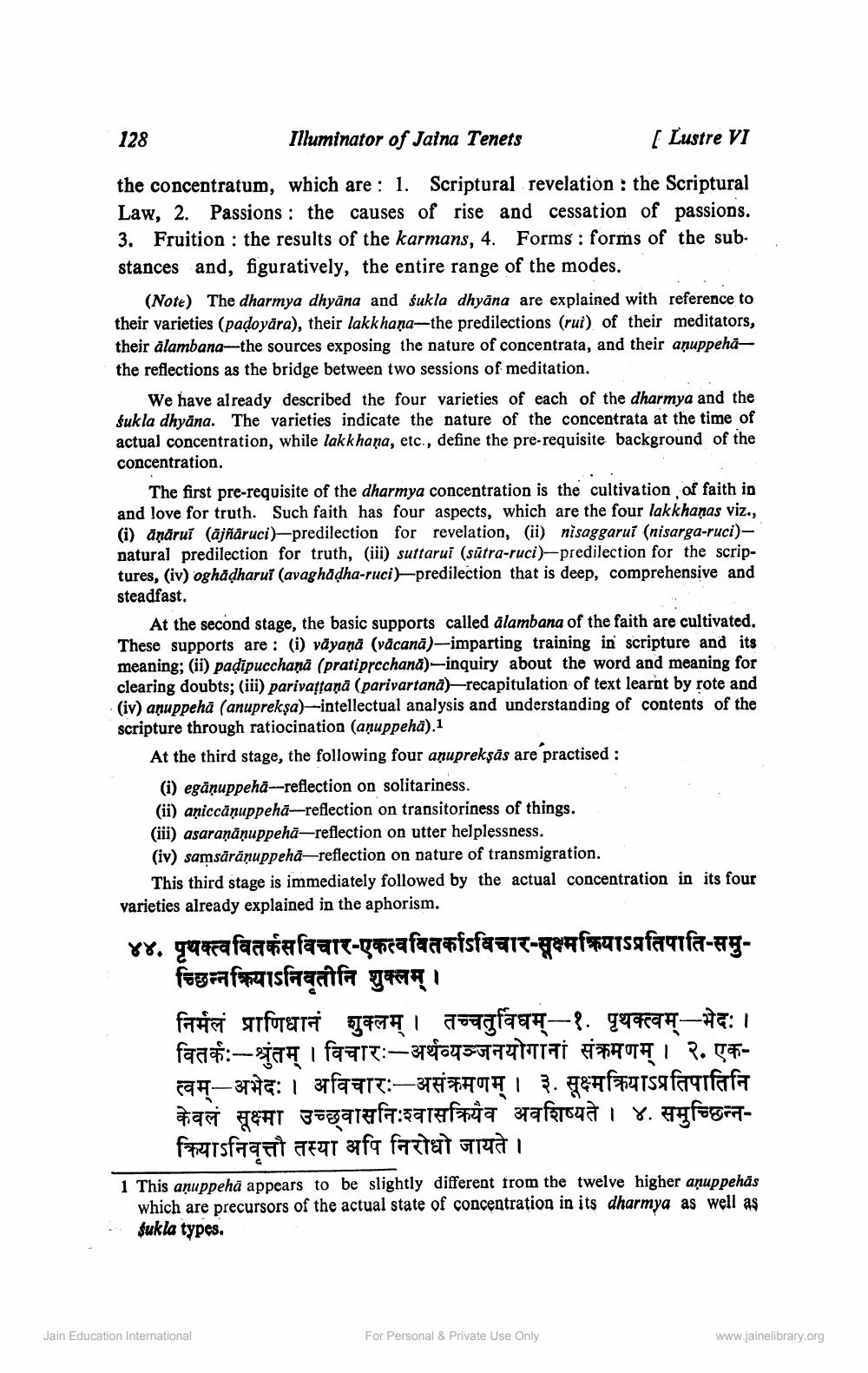________________
128
Illuminator of Jaina Tenets
[ Lustre VI
the concentratum, which are: 1. Scriptural revelation : the Scriptural Law, 2. Passions: the causes of rise and cessation of passions. 3. Fruition : the results of the karmans, 4. Forms : forms of the substances and, figuratively, the entire range of the modes.
(Note) The dharmya dhyāna and śukla dhyāna are explained with reference to their varieties (padoyara), their lakkhaņa—the predilections (rui) of their meditators, their alambana-the sources exposing the nature of concentrata, and their aņuppehathe reflections as the bridge between two sessions of meditation.
We have already described the four varieties of each of the dharmya and the śukla dhyana. The varieties indicate the nature of the concentrata at the time of actual concentration, while lakkhana, etc., define the pre-requisite background of the concentration.
The first pre-requisite of the dharmya concentration is the cultivation of faith in and love for truth. Such faith has four aspects, which are the four lakkhaņas viz., (i) āņārui (ājñāruci)--predilection for revelation, (ii) nisaggarui (nisarga-ruci), natural predilection for truth, (iii) suttarui (sūtra-ruci)-predilection for the scriptures, (iv) oghadharui (avaghādha-ruci) predilection that is deep, comprehensive and steadfast.
At the second stage, the basic supports called alambana of the faith are cultivated. These supports are : (i) vāyanā (vācana)-imparting training in scripture and its meaning; (ii) paļīpucchana (prati prcchanā)-inquiry about the word and meaning for clearing doubts; (iii) parivastaņā (parivartanah-recapitulation of text learnt by rote and (iv) anuppehā (anuprekșa)-intellectual analysis and understanding of contents of the scripture through ratiocination (anuppehā).1
At the third stage, the following four anuprekşās are practised :
(i) egāņuppeha--reflection on solitariness. (ii) aniccānuppehā-reflection on transitoriness of things. (iii) asaraņānuppehā-reflection on utter helplessness. (iv) samsäräņuppehå-reflection on nature of transmigration
This third stage is immediately followed by the actual concentration in its four varieties already explained in the aphorism. ४४. पृथक्त्ववितर्कसविचार-एकत्ववितर्काऽविचार-सूक्ष्मक्रियाऽप्रतिपाति-समु
च्छिन्नक्रियाऽनिवृतीनि शुक्लम् । निर्मलं प्राणिधानं शुक्लम् । तच्चतुर्विधम्-१. पृथक्त्वम्-भेदः । faasi- jaI faarT:—3781043FAUTIAI RATHI P. 54त्वम्-अभेदः । अविचारः-असंक्रमणम् । ३. सूक्ष्मक्रियाऽप्रतिपातिनि केवलं सूक्ष्मा उच्छ्वासनिःश्वासक्रियैव अवशिष्यते । ४. समुच्छिन्न
क्रियाऽनिवृत्तौ तस्या अपि निरोधो जायते । 1 This aņuppehā appears to be slightly different from the twelve higher anuppehās which are precursors of the actual state of concentration in its dharmya as well as $ukla types.
Jain Education International
For Personal & Private Use Only
www.jainelibrary.org




